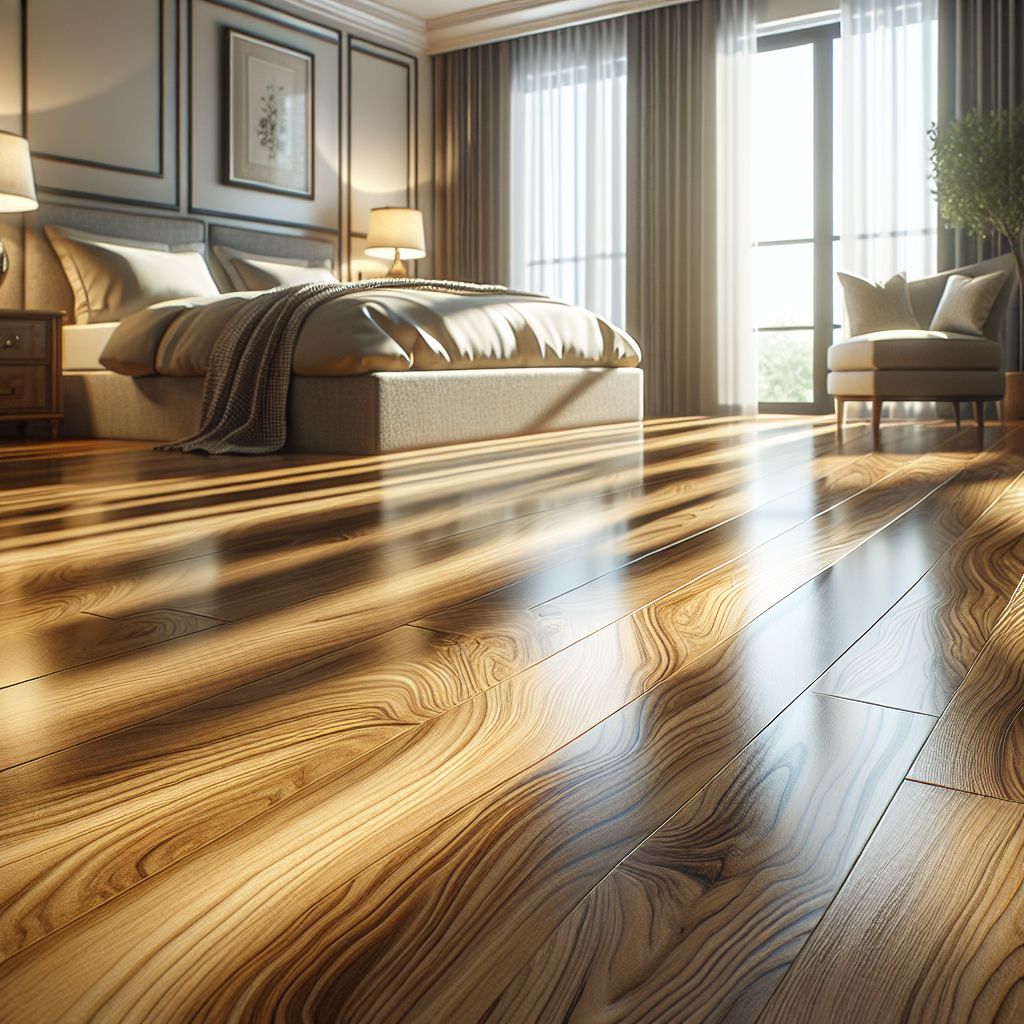
Key Takeaways
- Engineered hardwood floors can be refinished or remodeled, but each option suits different needs and situations.
- Refinishing is cost-effective and can extend the life of your floors, but it’s not always possible depending on the veneer thickness.
- Remodeling offers a fresh start and a chance to change your home’s aesthetic, though it’s a more significant investment.
- Before deciding, assess the condition of your floors and consider your long-term goals for your home.
- Maintenance post-refinish or remodel is essential to protect your investment and keep your floors looking great.
Crafted to Perfection: Exploring the Splendor of Engineered Hardwood Floors
When you step into a room, the floor can make or break the space. Engineered hardwood floors, known for their beauty and durability, are often the foundation of a room’s character. But what happens when they start to show their age? The good news is that you have options. Let’s dive into the world of refinishing and remodeling engineered hardwood floors to see which path suits you best.
Decoding Engineered Hardwood Floors: What You Need to Know
First things first, let’s understand what engineered hardwood floors are. These floors are constructed with a top layer of solid hardwood veneer attached to layers of plywood or high-density fiberboard. This makes them stable and less prone to warping compared to solid hardwood. But the key factor here is the thickness of the top veneer—it determines whether refinishing is even an option. The thicker the veneer, the more likely you can refinish your floors to bring them back to life.
Making the Choice: Refinish or Remodel?
So, you’re standing on your engineered hardwood floors and wondering whether to refinish what’s there or go for a total remodel. This decision isn’t just about aesthetics; it’s also about practicality and cost. But how do you decide? Let’s break it down.
What’s the Difference?
Understanding the difference between refinishing and remodeling engineered hardwood floors is critical when deciding which is better for your home.
Refinishing involves sanding down the top layer of wood to remove scratches, dents, and the old finish before applying a new stain and topcoat. It’s like giving your floor a facelift. Remodeling, on the other hand, means replacing the old floor with new material. It’s a complete overhaul that allows for a change in material, style, and color.
Assessing Your Engineered Floors’ Condition
Take a good look at your floors. Are there deep scratches, discoloration, or signs of water damage? If the damage is mostly superficial, refinishing might be the way to go. However, if you find that the damage has penetrated into the wood layers or if the veneer is too thin, remodeling might be your only option.
- Check for deep scratches and gouges that don’t come out with surface cleaning.
- Look for signs of water damage, like warping or buckling.
- Measure the veneer thickness to determine if refinishing is possible.
Refinishing vs Remodeling: Quick Comparison
| Refinishing | Remodeling | |
|---|---|---|
| Cost | $3 to $7 per square foot | $8 to $12 per square foot |
| Timeline | A few days to a week | Several days to a few weeks |
| Pros | Cost-effective, eco-friendly, quick process | Complete transformation, fixes underlying issues, opportunity to upgrade |
| Cons | Temporary solution, limited customization | High upfront cost, time-consuming, creates more waste |
To Refinish or Remodel: What Should You Choose?
Deciding whether to refinish or remodel your engineered hardwood floors isn’t a choice to make lightly. Besides assessing the condition of your floors, think about your long-term goals for your home. Are you looking to sell soon or stay put and enjoy the renovations? Are you craving a completely new look, or do you just want to restore the existing charm? Weighing these considerations will steer you toward the right decision for your space and your life.

Exploring the Pros and Cons of Refinishing and Remodeling Engineered Hardwood Floors
When considering the options for your engineered hardwood floors, understanding the pros and cons of refinishing versus remodeling is essential to making an informed decision that suits your home’s needs and your personal preferences.
Let’s get into the nitty-gritty. Each option has its benefits and drawbacks, and it’s important to understand these before making a choice.
Refinishing Advantages
- Cost-effective: Refinishing is typically less expensive than a full remodel.
- Time-saving: The process is quicker taking only a few days to a week, meaning less disruption to your daily life.
- Eco-friendly: You’re not throwing away material, which is better for the environment.
Refinishing Disadvantages
- Color restrictions: You may be limited in changing the color of your floors.
- Temporary solution: While refinishing can extend the life of your floors, it doesn’t last forever.
Remodeling Benefits
- Complete transformation: You have the freedom to change the entire look of your floors.
- Upgrade options: It’s an opportunity to upgrade to higher-quality materials.
- Fix underlying issues: Remodeling allows you to address any subfloor problems.
Remodeling Drawbacks
- Higher cost: A full remodel is a larger financial investment than refinishing.
- More time-consuming: The process can take longer from several days to a few weeks, especially if subfloor work is needed.
- Less environmentally friendly: Removing the old flooring creates more waste.

The Art of Refinishing
Refinishing engineered hardwood floors can breathe new life into your space. If you’ve determined that your floors are a good candidate for refinishing, congratulations! You’re on your way to a home transformation that’s both beautiful and budget-friendly. Remember, the goal is to restore, not replace, and with the right approach, your floors will look as good as new.
How to Tell if Your Engineered Floors Can be Refinished
Before you get started, you need to make sure your engineered floors are thick enough to handle the refinishing process. Generally, if the veneer is at least 2mm thick, you can sand and refinish the floors. If it’s less than that, you risk sanding down to the plywood underneath, which would ruin the floor.
DIY Refinishing: A Step-by-Step Guide
- Inspect your floors to ensure the veneer is thick enough for refinishing.
- Gather your tools: a sander, sandpaper, stain, and polyurethane finish.
- Start sanding: Begin with coarse sandpaper and work your way to finer grits.
- Clean the floors thoroughly after sanding to remove all dust and debris.
- Apply the stain evenly, if desired, and let it dry completely.
- Finish with several coats of polyurethane, allowing each coat to dry before applying the next.
The Path to Remodeling
When refinishing isn’t an option or if you’re simply ready for a big change, remodeling your engineered hardwood floors can completely alter the feel of your home. It’s a chance to start fresh and create the space you’ve always dreamed of.
When Remodeling is the Right Move
Remodeling is ideal when your floors are beyond repair or when you want to significantly change your home’s design. It’s also the right move if you’re dealing with persistent issues like moisture damage or if the layout of your home is changing and the old floors won’t fit the new design.
Choices in Engineered Hardwood for Remodeling
When you decide to remodel, you’ll find a wide range of engineered hardwood options. From different wood species to various finishes and plank sizes, the choices are nearly limitless. This is your chance to pick floors that not only look stunning but also match your lifestyle and the wear and tear they’ll endure.
Expert Tips for Remodeling with New Flooring
Seek advice from flooring professionals to find the best match for your needs. Consider factors like the hardness of the wood, the finish, and the installation process. Remember, the right choice will serve you well for years to come, so take your time and choose wisely.

Cost Analysis: Calculating the Investment
Let’s talk numbers. The cost of refinishing or remodeling your engineered hardwood floors can vary widely, but having a ballpark figure helps in planning your budget.
Refinishing Costs vs. Remodeling Expenses
Refinishing your engineered hardwood floors usually costs between $3 to $7 per square foot, while remodeling can range from $8 to $12 per square foot, depending on the material and labor costs. Remember, these are just estimates, and the actual cost will depend on various factors like the size of your space and the complexity of the job.
Long-term Value: Which Option Adds More?
Most importantly, consider the long-term value. Refinishing can enhance the look and longevity of your floors without a hefty price tag. However, if your floors are severely damaged or outdated, remodeling might be a better investment, potentially increasing your home’s value and appeal to future buyers.
Unlock Potential: Design and Style Considerations
Whether you’re refinishing or remodeling, design and style are at the forefront of the decision-making process. The choice you make can dramatically influence the ambiance of your home. Refinishing allows you to update the look within certain limits, while remodeling opens up a world of design possibilities.
Visual Impact: Refinishing and Color Transformation
Refinishing gives you the chance to alter the color of your engineered hardwood floors. Dark stains can create a sophisticated, formal look, while lighter stains offer a casual, airy feel. However, the original color and grain of the wood may limit how much you can change the floor’s appearance. It’s essential to test stains before committing to ensure you achieve the desired outcome.
Modern Trends in Engineered Hardwood Flooring
- Wide planks that give the illusion of more space.
- Gray and whitewashed tones for a contemporary vibe.
- High variation floors that showcase different shades and tones.
- Matte and satin finishes that reduce glare and hide imperfections.

Practical Insights: Durability and Lifestyle Fit
Engineered hardwood floors need to match your lifestyle. If you have a busy household with pets and kids, durability will be a top priority. The good news is that both refinishing and remodeling can enhance the resilience of your floors. A new finish can protect against scratches and stains, while choosing a harder wood species during a remodel can withstand more wear and tear.
Wear and Tear: What Your Floors Say About Your Lifestyle
Your floors are a reflection of your life—they tell a story of every step, spill, and celebration. High-traffic areas may show more wear, indicating a bustling, active home. If you notice certain areas wearing down faster than others, it might be time to consider refinishing your engineered hardwood floors to ensure your floors continue to stand up to your lifestyle.
- Consider the hardness rating of the wood for high-traffic areas.
- Look for finishes that offer enhanced protection for busy households.
- Choose a color and grain that can help conceal minor damage.
Maintaining Your Investment Post-Refinish or Remodel
After you’ve invested time and money into refinishing or remodeling your engineered hardwood floors, proper maintenance is key to keeping them looking their best. Regular cleaning, using protective pads under furniture, and addressing spills promptly will go a long way in preserving the beauty of your floors.

Frequently Asked Questions
How Often Can Engineered Hardwood Floors be Refinished?
Engineered hardwood floors can generally be refinished 1-2 times during their lifespan. The exact number depends on the thickness of the top veneer layer. It’s essential to consult with a professional to assess whether your floors are candidates for refinishing.
- Check the manufacturer’s recommendations on refinishing.
- Consider the age and condition of your floors before refinishing.
Remember, every time you refinish, you’re removing a thin layer of wood. If your floors have been refinished before, you’ll need to determine if they can handle another round.
Can All Types of Engineered Floors be Remodeled?
Yes, all types of engineered floors can be remodeled. However, some factors can affect the ease and cost of the process, such as the existing floor’s installation method and the condition of the subfloor.
Do Refinishing and Remodeling Have Different Environmental Impacts?
Yes, they do. Refinishing typically has a lower environmental impact because it involves less waste and uses fewer resources. Remodeling, on the other hand, can generate waste from the old flooring materials unless they are recycled or repurposed.
How Long Does Each Process Take From Start to Finish?
Refinishing engineered hardwood floors can take anywhere from a few days to a week, depending on the area’s size and the refinishing method. Remodeling can take longer, especially if there are issues with the subfloor or if you’re changing the layout of your space.
Should I Stay in My Home During Refinishing or Remodeling?
During refinishing, it’s often recommended to stay elsewhere due to the dust and fumes. With remodeling, you may be able to stay in your home, but be prepared for noise, disruption, and limited access to the area being worked on.





Leave a Reply